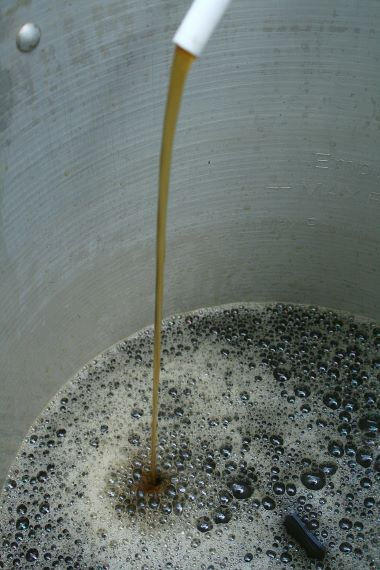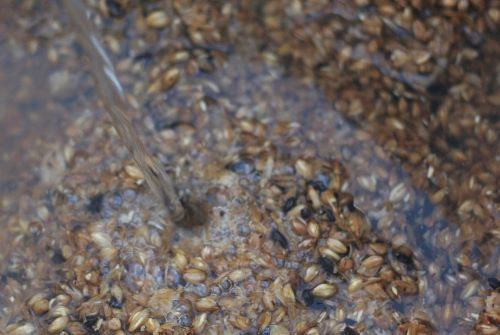Wort: Sweet Temptation for Beer-Making Yeast
- Sylvia Rose

- Feb 12
- 5 min read
Updated: Feb 15
Wort is the sweet liquid forming the basis of yeast fermentation in brewing. Made from malt grains, the sugary wort gives yeast a delicious incentive to create alcohol and carbon dioxide, a process used for thousands of years.

About Wort in Brewing
Wort is the liquid extracted from the mashing process during brewing, primarily composed of water, malt sugars, and various nutrients. It's the foundation of beer before fermentation takes place.
A sweet, sticky substance, wort is created when malted barley or other grain is steeped with hot water, which softens and swells the starches. This facilitates enzymatic conversion of starch into fermentable sugars.
The quality and composition of the wort directly influence the beer's flavor, color, and aroma. It also has an effect on alcohol content.

Brewing Process: Creation of Wort
Milling: The brewing process begins with milling, where grains are crushed to expose their starches. This increases the surface area available for enzymes to work on during mashing.
Mashing: In mashing, the crushed grains are mixed with hot water in a mash tun. The heat activates enzymes in the malt to convert starches into simple sugars.
Temperature is closely monitored to optimize enzyme effectiveness. Ideal temperatures range from 65°-70°C (150°-158°F) to convert starch to sugars efficiently. Wild yeast dies at 60°C (140°F).

Lautering: The wort is separated from the solid grain particles in lautering. It creates thick, sweet liquid with solid grain husks filtered out. The liquid is collected and further boiled to sterilize it and extract flavors from hops.
Boiling & Hopping: When the wort is boiled, hops are added for flavor, bitterness and aroma. The boiling process helps extract essential oils from the hops and kills unwanted microorganisms.
Cooling and Fermentation: After boiling, the wort is rapidly cooled and transferred to a fermentation vessel before yeast is added. Yeast ferments sugars in the wort to produce alcohol, carbon dioxide, and flavor esters, transforming it into beer.

Brewers might also add hops during fermentation to enhance the beer's flavor profile. Some wait until after fermentation to minimize losses in case of beer spoilage, as the hops can have an off-tasting bitterness.
Different hops provide bittering and aromatic characteristics, enriching the final product. For example, adding Cascade hops can impart floral notes, while Simcoe hops can add a more piney flavor.

Effect of Wort in Brewing
Flavor and Aroma
The types of grains used in mashing significantly influence the taste of the wort. The selection of hops during the boiling process can impart floral, fruity, or herbal aromas to the wort.
Sugar Content and Alcohol Production
The sugar concentration in the wort directly affects the resultant beer’s alcohol content. Breweries often measure the specific gravity, or density, of the wort before fermentation. Higher sugar levels lead to greater alcohol production during fermentation, allowing brewers to tailor the beer’s strength.
Color
Wort color varies based on the malts used. The color is often an indicator of the beer’s style; for instance, a pale ale will have a lighter wort compared to a stout or porter, which are dark due to the use of highly roasted malts.

Common wort types:
1. Pale Ale Wort
Pale ales primarily use pale malt, resulting in a light, amber-colored wort with moderate sweetness. This foundation is key in beers like Sierra Nevada Pale Ale, which has an alcohol content of around 5.6% and a balanced, hoppy flavor.
2. Stout Wort
In stouts, darker malts, such as roasted barley, create a rich, complex wort. This type of wort often features deeper colors and flavors that evoke coffee and chocolate. Guinness Draught has about 4.2% alcohol and is known for its rich and creamy texture (common buzzword "mouthfeel").

3. Wheat Beer Wort
Wheat beers use a predominant amount of wheat malt, leading to a hazy and fruity wort. In Belgian-style wheat beers like Blue Moon, adding coriander and orange peel enhances the flavor profile, resulting in a refreshing beverage that is light and flavorful.
4. Specialty Wort
Craft brewers frequently experiment with specialty grains to create unique wort combinations. This approach yields diverse beers, such as a rye IPA, with more spiciness and flavor complexity than traditional IPAs.

Facts About Wort
Historical Significance: The word "wort" has Old English roots, derived from the term "wyrt," meaning "plant" or "herb." Historically, "wort" refers to any plant used for medicinal or culinary purposes, including the plants in early brewing practices.
Wort Chilling: After boiling, wort must be cooled rapidly to about 70°F (21°C) for ale fermentation or lower for lagers. Cooling prevents contamination and achieves favorable fermentation temperatures.
Wort Composition: The average wort used for brewing usually contains approximately 10-15% fermentable sugars. On average, 1 pound of malt can yield about 0.1-0.2 gallons of wort.

Sugar Content Measurement: The sugar content in wort is measured by specific gravity, an essential metric for brewers to predicts potential alcohol content. A wort with specific gravity of 1.050 can yield beer with about 5% alcohol by volume after fermentation.
Innovative Brews: Some breweries experiment with unique ingredients to create specialty worts, incorporating fruits, herbs and spices to redefine traditional styles and develop distinctive flavors.

Wort in Homebrewing: Homebrewing enthusiasts often start with pre-made extract worts, simplifying the brewing process. This allows beginners to focus on fermentation and flavoring without dealing with the complexities of mashing.
Easy Homebrewing: For homebrewers, pre-packaged wort kits are available, allowing hobbyists to explore brewing with minimal equipment. These kits simplify the process by providing a pre-mixed wort for brewing.

Non-Fiction Books:
Fiction Books:
READ: Lora Ley Adventures - Germanic Mythology Fiction Series
READ: Reiker For Hire - Victorian Detective Murder Mysteries


